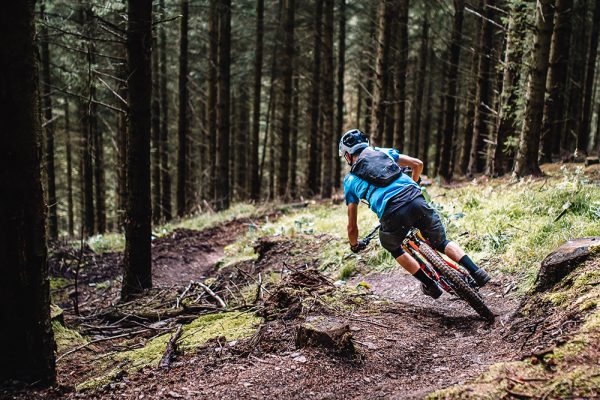Guy Kesteven weighs up the wild trial situation. With more and more unsanctioned trails being built, are they at risk of damaging landscapes, or is there a way forward that conserves the environment and the thrill they bring?
Cheeky. Secret. Natural. Unsanctioned… Illegal? Whatever you want to call them, we nearly all ride these trails. They’re more prolific than ever and frankly, from a pure riding point of view, that’s fantastic. But with land use becoming increasingly pressured and rider numbers growing, what are the implications of carving slot-racing scars into hillsides without giving a shit about sustainability or the wider impact? How do we handle this ‘infestation’ going forward and are there any examples where problems have been managed into a really valuable positive rather than being seen as reckless vandalism?
Last month I talked about how trail centres still have a place, but the truth is ‘official’ trails don’t come anywhere near to satisfying demand, and they never have. Outside of ‘pay to play’ bike parks there’s barely 1,000km of official trail centre riding in the UK. Most of that was only designed for sketchy, small wheeled, high post hardtails over twenty years ago and they’ve largely been left to disintegrate since.

Not everyone has open-access trails or bridleways near them to give that wild ride experience
No surprise then that a lot of mountain bikers are returning to the literal roots of the sport. Well before mountain bike trail centres – and even before mountain bikes – riders were adopting natural deer, sheep or dog walking tracks and making them more fun for riding down. In fact the entire race scene was – and still is – based on these sorts of built trails, not least because racing on bridleways or other ‘legal’ access routes is against the law.
More progressive ‘pay to play’ bike parks like Aston Hill, then BPW, Rogate, Dyfi, Revs etc. then joined race tracks as the places to go to push ever more capable, faster bikes. Flow fans wanted to have that stoke on their own trails too and suddenly jumps, berms and other features started appearing on local trails and often alongside ‘official’ ones too. Some inevitably caused build/demolish/rebuild fights with landowners but mostly it was a case of blind eyes being turned by the authorities as long as nobody really took the piss with rider volume or visibility.
The trouble is though that both volume and visibility have exploded in the last few years. Apps like Trailforks and Strava mean you’ll find riders from hours drives away at tiny local spots, and have you even ridden somewhere if you’ve not shot a ‘shreddit’ for Insta? Lockdown was an epidemic of trail building that created some beautiful, sustainable, meticulously maintained tracks.
However it’s also seen a load of areas scarred with snaking ruts ridden to death and then recut metres away with no thought for delicate landscapes, wildlife disturbance, water run off or how these ugly gashes look to other countryside users.
While it’s thankfully rare, the potential for serious accidents and incidents is a massive litigation worry for landowners who know that ‘turning a blind eye’ won’t stand up in court. Add intimidatingly high rider speeds, goggles and full face helmets, disruptive/damaging parking plus increased noise and littering issues in areas that are normally sought out for serenity and ‘nature bathing’ calmness and we can easily look like a blight not a bonus, however much we spend in the local shop/cafe/pub.

The Golfie singletrack in the Tweed Valley is managed by the TVTA
It’s not all heading downhill though. Tweed Valley is a brilliant example of forward thinking land managers and more patient trail builders forming relationships that have seen tracks like the Golfie group adopted as official options. As a result Innerleithen has not only become a thriving – and prosperous – MTB resort, booked out months in advance for events like Tweedlove or the EWS. It’s also the site of a dedicated MTB industry park and home to ground breaking mental health work with DMBINS and Scottish universities.
The Forest of Dean and Sheffield are other great examples of co-operation creating excellent sustainable trails and there are dozens of different trail building associations currently working with landowners to create sustainable solutions. While it’s never worked previously there are several current initiatives to try and create an overall mountain bike advocacy collective that can sit alongside very well funded, established and organised hiking and horse groups and give mountain biking a voice in official negotiation meetings.

If you ride, you should consider joining a dig. Or donating some money, or doing a DIY litter pick. Basically, if you get fun out, it’s worth giving a little back in.
The more riders who get involved in these groups, the more rightful representation mountain biking can get at higher levels, and if you haven’t got a local group you can always start one yourself. But most importantly we can still make a positive impact every time we ride.
Whether that’s helping with maintenance of sustainable trails, not schralping rare birds’ nests, picking up litter, making sure we park where it doesn’t block access or damage verges and thinking of the wider implications of uploading secret trails onto ride apps and social media. And of course slowing down/stopping, saying hello, patting dogs, passing the time of day and just generally coming across as a decent human when you meet other trail users should go without saying.
Heading out to go ride and looking for destination inspiration? How about checking out the best new trails to ride in 2023? Or how about Britain’s best flow trails? And if the weather is wet and horrible, there’s always trails the ride well in the wet.




